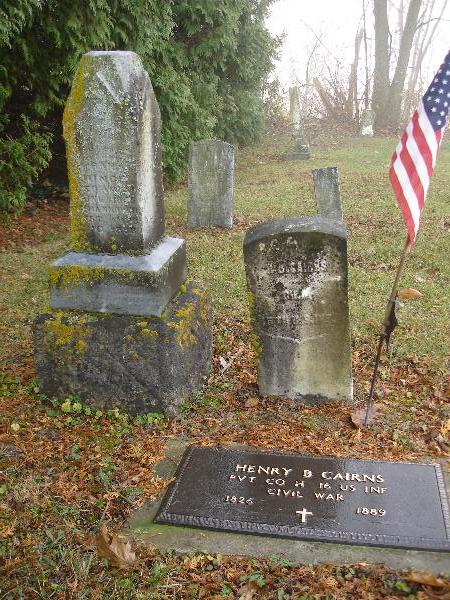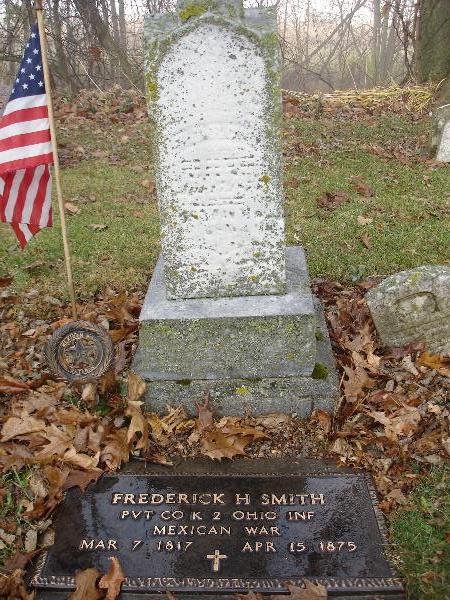Ohio Spirit Quest # 58 - "MANIFEST DESTINY" Traditional Cache
Ohio Spirit Quest # 58 - "MANIFEST DESTINY"
-
Difficulty:
-

-
Terrain:
-

Size:  (small)
(small)
Please note Use of geocaching.com services is subject to the terms and conditions
in our disclaimer.
"Ohio Spirit Quest"
The Ohio Spirit Quest series of geocaches will take you to a number of historic cemeteries built by Buckeye Pioneers. This series is inspired by and a continuation of the Indiana Spirit Quest caches created by Six Dog Team. In just over three years, the SPIRIT QUEST has grown to over 550 caches, with the hiding teams growing as well. The Ohio Spirit Quest has grown to over 30 in Ohio, with five current caching teams, three each with A Man and His Dog, one with a Couple and Their Dog... and one with A Woman and her Dog.
Over 1,000 cachers have logged over 20,000 finds. One cache machine found 111 ISQ caches in a single day (daylight hours only).

Welcome to Knipp Cemetery

Flatrock Township, Henry County, Ohio

OHIO SPIRIT QUEST #58
"MANIFEST DESTINY"

Knipp cemetery has bronze VA markers from four different US conflicts. One of those conflicts was the "Mexican War".

I am sure most of you remember the phrase "Manifest Destiny" from history class in school. But do you remember what it means, or the consequences from the pursuit of manifest destiny?
The Mexican War took place from 1846 to 1848. The Mexican-American War was the first major conflict driven by the idea of "Manifest Destiny"; the belief that America had a God-given right, or destiny, to expand the country's borders from 'sea to shining sea'. This belief would eventually cause a great deal of suffering for many Mexicans, Native Americans and United States citizens. Following the earlier Texas War of Independence from Mexico, tensions between the two largest independent nations on the North American continent grew as Texas eventually became a U.S. state. Disputes over the border lines sparked military confrontation, helped by the fact that President Polk eagerly sought a war in order to seize large tracts of land from Mexico.

The war between the United States and Mexico had two basic causes. First, the desire of the U.S. to expand across the North American continent to the Pacific Ocean caused conflict with all of its neighbors; from the British in Canada and Oregon to the Mexicans in the southwest and, of course, with the Native Americans. Ever since President Jefferson's acquisition of the Louisiana Territory in 1803, Americans migrated westward in ever increasing numbers, often into lands not belonging to the United States. By the time President Polk came to office in 1845, an idea called "Manifest Destiny" had taken root among the American people, and the new occupant of the White House was a firm believer in the idea of expansion. The belief that the U.S. basically had a God-given right to occupy and "civilize" the whole continent gained favor as more and more Americans settled the western lands. The fact that most of those areas already had people living upon them was usually ignored, with the attitude that democratic English-speaking America, with its high ideals and Protestant Christian ethics, would do a better job of running things than the Native Americans or Spanish-speaking Catholic Mexicans. Manifest Destiny did not necessarily call for violent expansion. In both 1835 and 1845, the United States offered to purchase California from Mexico, for $5 million and $25 million, respectively. The Mexican government refused the opportunity to sell half of its country to Mexico's most dangerous neighbor.
The second basic cause of the war was the Texas War of Independence and the subsequent annexation of that area to the United States. Not all American westward migration was unwelcome. In the 1820's and 1830's, Mexico, newly independent from Spain, needed settlers in the underpopulated northern parts of the country. An invitation was issued for people who would take an oath of allegiance to Mexico and convert to Catholicism, the state religion. Thousands of Americans took up the offer and moved, often with slaves, to the Mexican province of Texas. Soon however, many of the new "Texicans" or "Texians" were unhappy with the way the government in Mexico City tried to run the province. In 1835, Texas revolted, and after several bloody battles, the Mexican President, Santa Anna, was forced to sign the Treaty of Velasco in 1836 . This treaty gave Texas its independence, but many Mexicans refused to accept the legality of this document, as Santa Anna was a prisoner of the Texans at the time. The Republic of Texas and Mexico continued to engage in border fights and many people in the United States openly sympathized with the U.S.-born Texans in this conflict. As a result of the savage frontier fighting, the American public developed a very negative stereotype against the Mexican people and government. Partly due to the continued hostilities with Mexico, Texas decided to join with the United States, and on July 4, 1845, the annexation gained approval from the U.S. Congress.
Mexico of course did not like the idea of its breakaway province becoming an American state, and the undefined and contested border now became a major international issue. Texas, and now the United States, claimed the border at the Rio Grande River. Mexico claimed territory as far north as the Nueces River. Both nations sent troops to enforce the competing claims, and a tense standoff ensued. On April 25, 1846, a clash occurred between Mexican and American troops on soil claimed by both countries. The war had begun.

The Mexican-American War was largely a conventional conflict fought by traditional armies consisting of infantry, cavalry and artillery using established European-style tactics. As American forces penetrated into the Mexican heartland, some of the defending forces resorted to guerrilla tactics to harass the invaders, but these irregular forces did not greatly influence the outcome of the war.
After the beginning of hostilities, the U.S. military embarked on a three-pronged strategy designed to seize control of northern Mexico and force an early peace. Two American armies moved south from Texas, while a third force under Colonel Stephen Kearny traveled west to Sante Fe, New Mexico and then to California. In a series of battles at Palo Alto and Resaca de Palma (near current-day Brownsville, Texas), the army of General Zachary Taylor defeated the Mexican forces and began to move south after inflicting over a thousand casualties. In July and August of 1846, the United States Navy seized Monterey and Los Angeles in California. In September, 1846, Taylor's army fought General Ampudia's forces for control of the northern Mexican city of Monterey in a bloody three-day battle. Following the capture of the city by the Americans, a temporary truce ensued which enabled both armies to recover from the exhausting Battle of Monterey. During this time, former President Santa Anna returned to Mexico from exile and raised and trained a new army of over 20,000 men to oppose the invaders. Despite the losses of huge tracts of land, and defeat in several major battles, the Mexican government refused to make peace. It became apparent to the Polk Administration that only a complete battlefield victory would end the war. Continued fighting in the dry deserts of northern Mexico convinced the United States that an overland expedition to capture of the enemy capital, Mexico City, would be hazardous and difficult. To this end, General Winfield Scott proposed what would become the largest amphibious landing in history, (at that time), and a campaign to seize the capital of Mexico.

On March 9, 1847, General Scott landed with an army of 12,000 men on the beaches near Veracruz, Mexico's most important eastern port city. From this point, from March to August, Scott and Santa Anna fought a series of bloody, hard-fought battles from the coast inland toward Mexico City. The more important battles of this campaign include the Battles of : Cerro Gordo (April 18), Contreras (August 20), Churubusco (August 20), Molino del Rey (September 8) and Chapultepec (September 13). Finally, on September 14, the American army entered Mexico City. The city's populace offered some resistance to the occupiers, but by mid-October, the disturbances had been quelled and the U.S. Army enjoyed full control. Following the city's occupation, Santa Anna resigned the presidency but retained command of his army. He attempted to continue military operations against the Americans, but his troops, beaten and disheartened, refused to fight. His government soon asked for his military resignation. Guerrilla operations continued against Scott's lines of supply back to Veracruz, but this resistance proved ineffective.

On February 2, 1848, The Treaty of Guadeloupe Hidalgo was signed, later to be ratified by both the U.S. and Mexican Congresses. The treaty called for the annexation of the northern portions of Mexico to the United States. In return, the U.S. agreed to pay $15 million to Mexico as compensation for the seized territory. The bravery of the individual Mexican soldier goes a long way in explaining the difficulty the U.S. had in prosecuting the war. Mexican military leadership was often lacking, at least when compared to the American leadership. And in many of the battles, the superior cannon of the U.S. artillery divisions and the innovative tactics of their officers turned the tide against the Mexicans. The war cost the United States over $100 million, and ended the lives of 13,780 U.S. military personnel. America had defeated its weaker and somewhat disorganized southern neighbor, but not without paying a terrible price.
Congrats to THunter for the
F.T.F.!!!
 The cache container is small Lock & Lock.
The cache container is small Lock & Lock.
If you find a fallen US flag, please stick it back in the ground. As always, please be respectful, and cache in, trash out.
Placed by a member of:

"Ohio Spirit Quest" is brought to you by the following fellows of GEOOSQ*: The SixDogTeam, THE SHADOW, The Moop Along, -Eleanor-, TeamMina, Handyman & Fam. If you are interested in spreading the Quest to your neck of the woods AND WOULD LIKE TO JOIN US, email Handyman & Fam with your caching resume and at least 25 current notarized references.
*Grand Exalted Order of the Ohio Spirit Quest*

Additional Hints
(Decrypt)
haqre przrag, 6gu sebz gur evtug